Menu
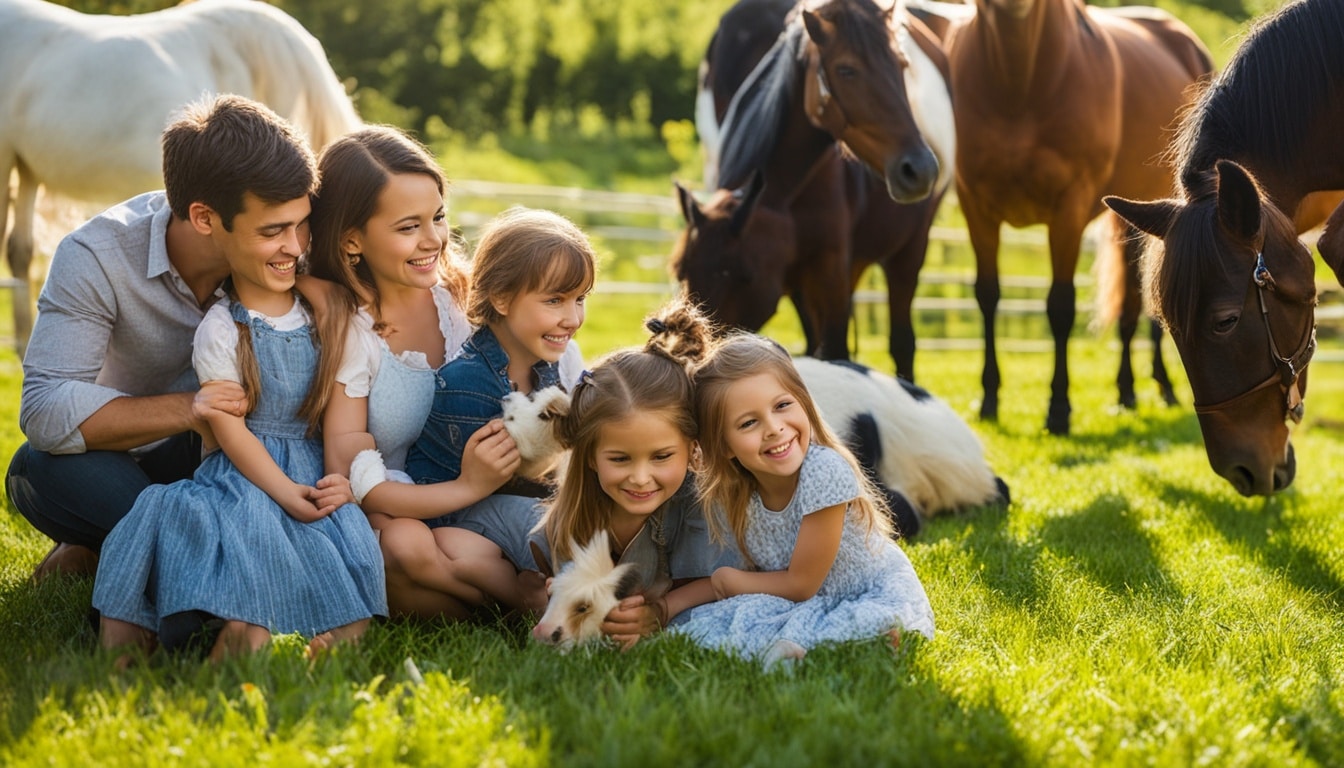
Did you know that animal scientists have found a link between the well-being of dairy cows and their milk production? By adding farm animals to the guest experience, agritourism can take a giant step forward. This new method not only makes farm tours more worthwhile but also helps people understand local food production better.
Agritourism lets visitors directly engage with farming and country life. Take Oregon, for example. There, farmers have seen how simple farm activities can keep guests intrigued. But, to have great experiences with farm animals, farms must plan carefully. They need to make sure visitors and animals are safe and happy, picking the right animals and preparing the right places. This way, they’ll leave a lasting memory on their guests.
Agritourism acts as a educational bridge between those in cities and farm life. It allows city people to enjoy the quiet and simple life of the countryside, far from the busyness of urban areas. There is a big agritourism benefit seen from letting visitors stay on farms. It helps visitors value farming and nature more.
The recent numbers show how much people enjoy and spend on agritourism. From 2007 to 2012, farms open to visitors grew from 10,249 to 13,334 in the US. This growth led to more income, jumping from $546 million to $674 million. It shows a rising interest in staying on farms and the value of these experiences to visitors.
Enhancing guest experience with farm animals is key in agritourism. It means having the right places and structures. Using animals in farms for visitors must be carefully thought out. This includes dealing with safety concerns and making sure there are proper facilities like restrooms and safe parking. This is to make visitors enjoy their time without worries.
The growing number of visitors clearly shows the appeal of agritourism. More than 75 million people visited farms between 2005 and 2009. This was a 28% rise from 2001. It means more city folks are interested in farm life. In California, for example, various operators showed different earnings in agritourism. 50% earned less than $10,000, while 21% made more than $100,000. This reveals the different incomes agritourism can bring.
| Time Period | Number of Farms Engaged in Agritourism | Gross Income | Visitor Numbers |
|---|---|---|---|
| 2007-2012 | 10,249 to 13,334 | $546 million to $674 million | 75 million people (2005-2009) |
In summary, agritourism is great for learning and business. It makes visiting farms an amazing experience for guests. With good planning, those running the farms can make visitors very happy. This in turn helps people value countryside living and farming even more.
Meeting farm animals brings deep rewards, making guests’ visits more enjoyable. It lets visitors make strong bonds, learn new things, and have fun in a special way.
A visit to a farm helps people connect with animals in a special, heartfelt way. This can make them feel happier, less stressed, or even at peace. At places like Blue Iris Farm, people often say they feel better after spending time with farm animals.
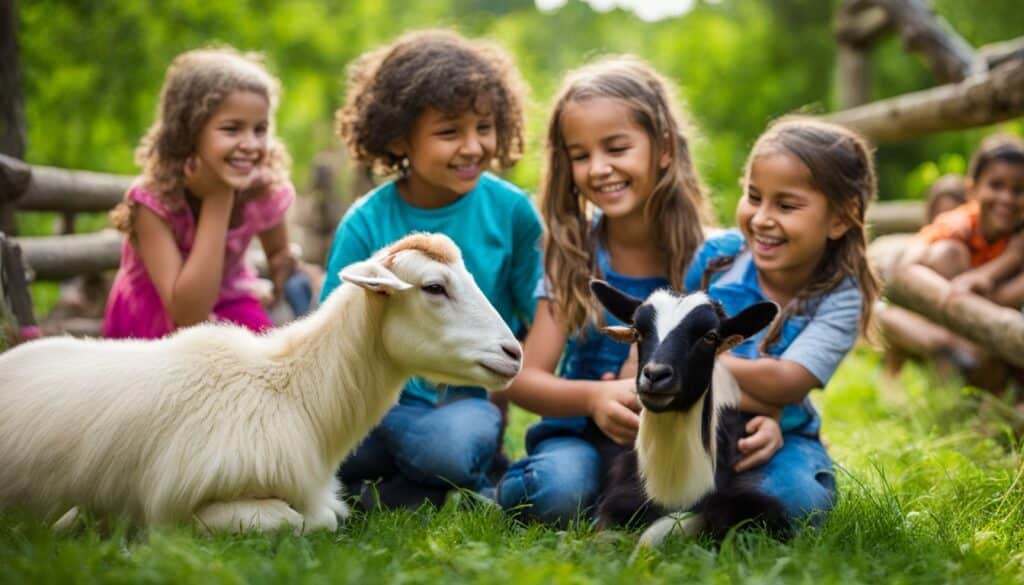
Farms offer lots to learn, letting guests of any age grow wiser about animals and farming. They get a close look at how farms work and why animals are so important. This not only teaches but also helps people value farms more.
Farm tours are full of fun, hands-on activities that turn learning into something they won’t forget.
Farm animals are not only fun to be around but draw in visitors wanting something new. There’s a lot to do like petting and feeding the animals. This makes it perfect for families. No matter your age, there’s an animal to meet.
In short, farm animal activities offer a mix of emotional, educational, and fun benefits. They make farm visits memorable and rewarding, giving a great all-round experience.
Interactive animal experiences can make visiting a place more fun and educational. With opportunities to touch and take part in activities with farm animals, guests connect deeply with the farm world.
Hands-on activities like milking goats or gathering eggs make a visit special. They turn a regular tour into an unforgettable experience by showing what daily farm life is like. This mix of fun and learning appeals to visitors of all ages.
Guided tours on a farm can focus on different themes or give a broad idea of farm work. They let guests learn about farming and meet the animals in a fun way. With expert guides, the tour is tailored to answer everyone’s questions and tell interesting stories.
Feeding animals is another way to enjoy and learn. Guests can feed goats, sheep, and other farm animals, getting closer to the farm life. This activity is fun and teaches visitors about the hard work of taking care of animals.
The Saint Louis Zoo and the Henry A. Jubel Foundation’s Destination Discovery are great examples. They show how to make engaging animal experiences. With a $15 million lead donation and a $40 million budget, it highlights the importance of hands-on activities with animals. Opening in 2026, this project will offer fun and educational activities with farm animals to make sure every visitor has a great time.
A thematic approach is key for educational farm animal experiences. It helps make the content engaging and suitable for different groups like schools or families. Themed tours can show the daily care of animals or how they help with eco-friendly farming.
When setting up these experiences, it’s crucial to follow laws like the Pennsylvania Animal Exhibition Sanitation law. This law asks for hand-cleaning stations to lower disease risks. It makes sure the place is both fun and safe for everyone.
Having the right biosecurity measures is also important. This means rules like visitors must wear clean shoes, controlled entry to the farm, and supervised animal interactions. Such practices are crucial for good animal care and visitor safety. They comply with the Animal Welfare Act to treat animals ethically.
A petting zoo must follow these biosecurity rules. It’s good for both animals and people. To make it even better, it’s wise to control how many visitors come in. This way, animals feel less stressed, and visitors learn more. A farm like Green Meadows has seen many visitors thanks to its well-planned experiences.
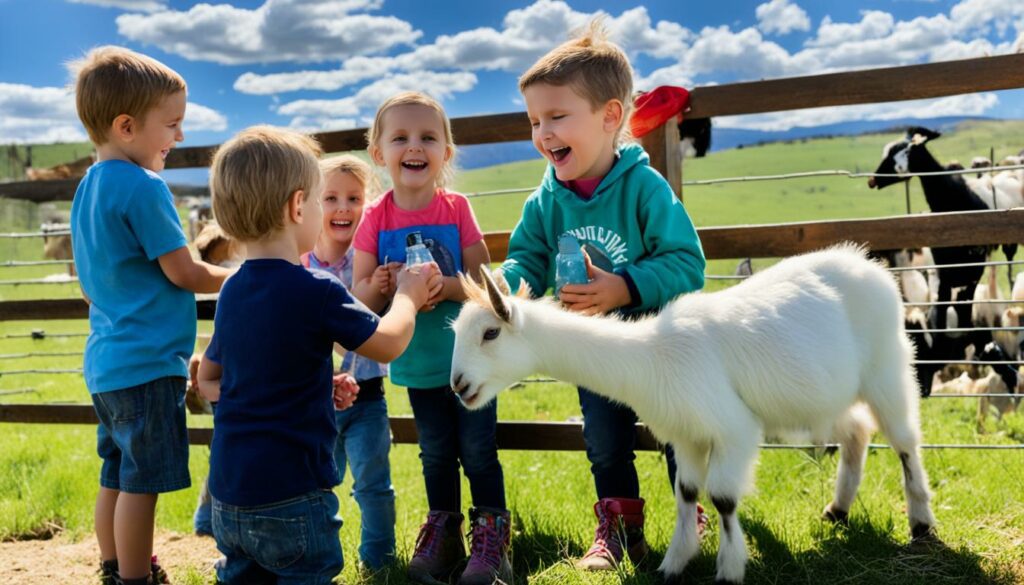
Places under the Animal Welfare Act get checked often to ensure they follow the rules. These checks are to make sure the educational activities with farm animals are of high quality. It builds trust with visitors.
In the end, having well-structured and themed educational farm stays does a lot. It not only makes visitors happy, but it also strengthens the tie between farms and the public. And by following biosecurity and laws, the experience with farm animals is both memorable and safe for everyone.
Setting up petting chances that are fun and safe takes key steps. We check what animals are the most welcoming. And we make sure that everything is really clean and safe. I’ll show you how to make a visit that’s great and safe for everyone.
We must pick animals that are gentle and social for people to meet. Not every farm animal is open to visitors. So, choosing ones that like human touch is very important. Vets regularly check on these animals. This makes sure they are healthy and happy for people to meet safely.
All visitors, whether they live nearby or from far off, need to keep clean. Farms should have places for people to wash their hands easily. Making sure people have clean shoes is a must. And keeping the whole farm clean helps stop sickness from spreading.
Also, having signs and telling people the rules helps keep the animal petting area safe. Laws in Pennsylvania make sure farms do their best to keep people safe from accidents. This shows how important it is to follow the rules to keep everyone safe.
| Key Safety Measures | Purpose |
|---|---|
| Handwashing Stations | Reduce risk of zoonotic disease transmission |
| Clean Footwear Policies | Maintain hygiene and biosecurity |
| Health Assessments | Ensure animal and human safety |
| Visitor Guidelines | Foster informed and safe interactions |
When we plan for people to pet the animals, we must focus on both fun and safety. Getting this balance right makes the visit unforgettable for all the right reasons. This is key in making sure the animal petting experience is both successful and fair to the animals.
Creating themed farm tours is a great way to interest visitors with different hobbies. These tours mix seasonal activities, unique farm knowledge, and fun for the family. They offer more than a visit, leaving a lasting memory of the farm.

Tours change with the seasons to match the farm’s activities. In spring, guests can learn about soil. In summer, they see how orchards are cared for. Autumn brings energy talks, and winter focuses on animal care. This lets visitors see the farm’s busy cycle every season.
Special tours dig into specific parts of farm life. They might explore sustainable farming, farm history, or unique skills like cheese-making. These tours offer detailed insights, making the farm’s story richer for visitors.
Tours for kids are full of fun and learning. They might include petting zoos or planting seeds. These activities are exciting and can teach children about farms. This makes the farm a great place for families to visit.
Themed farm tours are a hit because they offer something for everyone. The mix of seasonal fun, in-depth topics, and family activities creates an exciting trip. It is a recipe for a successful and enjoyable visit to the farm.
Combining close-up farm animal visits with wildlife encounters can make a visit special. I’ve seen that tours showing wildlife and farming life together give a fuller picture. These tours can show how local animals live while caring for farm animals’ happiness too.
One great thing about blending farming and wildlife is seeing animals in their natural-like settings. This reminds me of how good zoos design for animals’ needs, making them feel at home. By adding new and changing features to a farm—like Farm Sanctuary does—we help animals act naturally and keep happy.
A nice farm visit includes many ways to make animals’ lives interesting. This means setting up their areas to encourage natural behaviours like hiding, climbing, and looking for food. It’s also about giving them chances to be with others and have puzzles to solve.
Also, adding wildlife to a farm can boost income. Glamping is a posh camping that attracts people keen on nature, families, and those craving adventure. This mix of seeing wildlife on a farm and staying in luxury tents offers a new way to make money. It also makes guests want to come back, building a loyal following.
But, looking after the well-being of both types of animals needs careful planning. It’s vital to keep farmed animals happy and welcome wildlife without causing stress. Following good zoo practices in designing animal spaces and keeping them engaged allows for amazing wildlife tours.
In the end, wisely mixing farming and wildlife makes for a great learning trip for everyone. It helps us understand and value the world of farms and wildlife better.
Animal-assisted therapy plays a big part in making guests’ visits better at therapeutic farms. This sector is growing quickly across Europe. It combines health and social care with farming, helping people with various needs. These include those with mental health issues, dementia, young people facing difficulties, and those with intellectual disabilities. The key role of animals in improving human well-being is very important here.
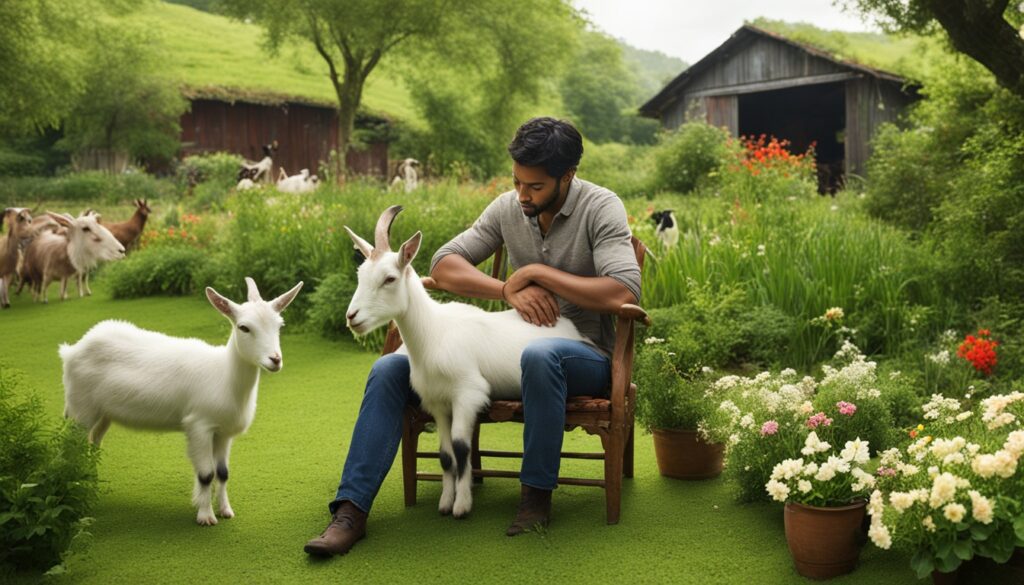
There are about 1100 care farms in the Netherlands and Norway showing how animals help people. They not only boost physical health but also mental and social well-being. Farm animals help in making connections, lowering stress, and providing social support. Research finds that being with animals helps build cherished relationships. This gives people a sense of purpose and more responsibility.
Animal therapy helps people relax through farm visits. These visits are becoming more popular for stress relief. Studies show that being with animals can reduce anxiety and encourage healthy behaviour. Care farms provide spaces where people can feed and groom animals. This kind of activity creates a calm and happy atmosphere, ideal for anyone looking to unwind.
Improving guest experiences with farmstays is key to making unforgettable memories. Leaping Lamb Farm, a family farm in the Coast Range, Oregon, leads the way. It’s located just 40 miles from the sea and 25 miles from Corvallis, offering a peaceful escape. The farm’s unique animal interactions leave a lasting impact on its guests.
Accommodating up to twelve guests, Leaping Lamb Farm focuses on personalised animal activities. Tours are kept small to make the experience more personal and fun. Guests can choose from feeding the animals, joining live farm tours, or picking seasonal fruits and vegetables. These activities match guests’ interests and make their stay special.
The farm’s animal experiences aim to entertain and teach, making each visit memorable. They also sell farm-fresh meat and unique items like t-shirts and hats at their shop. Guest reviews often rank the farm very highly, with scores between 4.89 and 5.0, showing their dedication to quality.
Here’s how Leaping Lamb Farm compares:
| Experience | Rating (out of 5) | Number of Reviews | Price Range (USD) |
|---|---|---|---|
| Leaping Lamb Farm Animal Interactions | 4.89 – 5.0 | 23 – 705 | 10 – 90 |
| Goat Snuggle Sessions | 4.9 | 180 | 20 – 50 |
| Dairy Farm Tours | 4.7 | 380 | 15 – 75 |
| Hiking with Goats | 4.8 | 250 | 35 – 80 |
| Beekeeping Experiences | 4.85 | 90 | 30 – 60 |
Leaping Lamb Farm’s approach guarantees guests have a great time and want to come back. This strategy is popular in many places including Rhode Island, Vermont, and California. It means farmstay experiences are known and loved all over the country.
Choosing the best farm animals for tours is key in making the visits engaging and educational in agritourism. You need to look at the animals’ nature, the farm’s facilities, and the goals of your tours. Picking a mix of farm animal encounters guarantees your guests remember the fun they had.
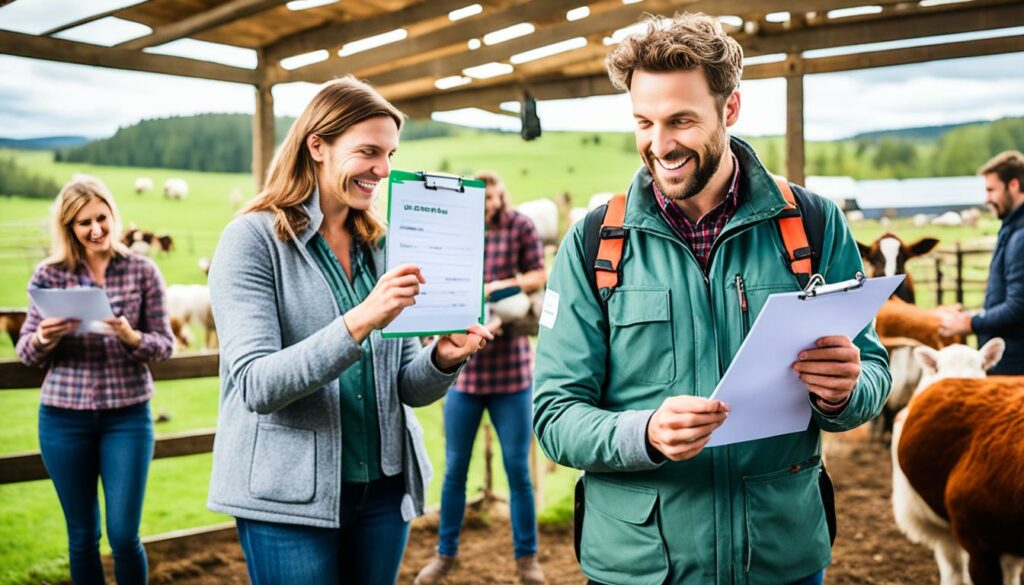
Farm animals like chickens, goats, and cows keep visitors interested and excited. Each animal type offers unique experiences. For example, chickens lay lots of eggs, which is interesting to see. Goats provide high-quality meat, and cows turn bad food into good protein.
It’s important to know about the animals’ climate needs, what they produce, and how efficiently they eat. Knowing that goats can make lean meat might attract people wanting to learn more about farming.
Guests must mix well with the animals. You must check if the animals are friendly and suitable for all guests. Keeping things clean and safe, like with handwashing, stops diseases from spreading. It’s also Pennsylvania’s law to teach about diseases and have clean hands places at farms.
Places like petting zoos get checked often for how well they treat animals and keep them stress-free. These zoos need to plan ahead, have strict rules, and make sure everyone follows them. This helps keep both the animals and visitors safe.
Farm animal management for tourism is key for great guest experiences. Animals must be well-trained for interactions, keeping both them and people safe. This involves setting up strict training and health rules.
To train animals for guest interactions, we start by knowing their behaviours. We then use various methods to teach them how to act around people. These methods include:
Keeping farm animals healthy is closely linked with keeping the guests safe. There are important health and safety rules to follow. For example:
Care farming is a new field that mixes farming with health care. It offers lots of benefits. Countries like The Netherlands and Norway have many care farms. These farms help reduce stress and build confidence in their participants. As I look into managing farm animals for tourism, focusing on good training and health rules is essential.
Keeping things clean on the farm is key for the animals and for welcoming visitors. I follow strict farm animal hygiene practices to keep my animals healthy and the area pleasant for guests.
Good care for dairy cows means more milk. They need top-notch food and regular check-ups from the vet. Also, I’ve installed a cow brush that turns by itself. This brush helps the cows stay clean and lets them do something they love – grooming themselves. It boosts their mood too.
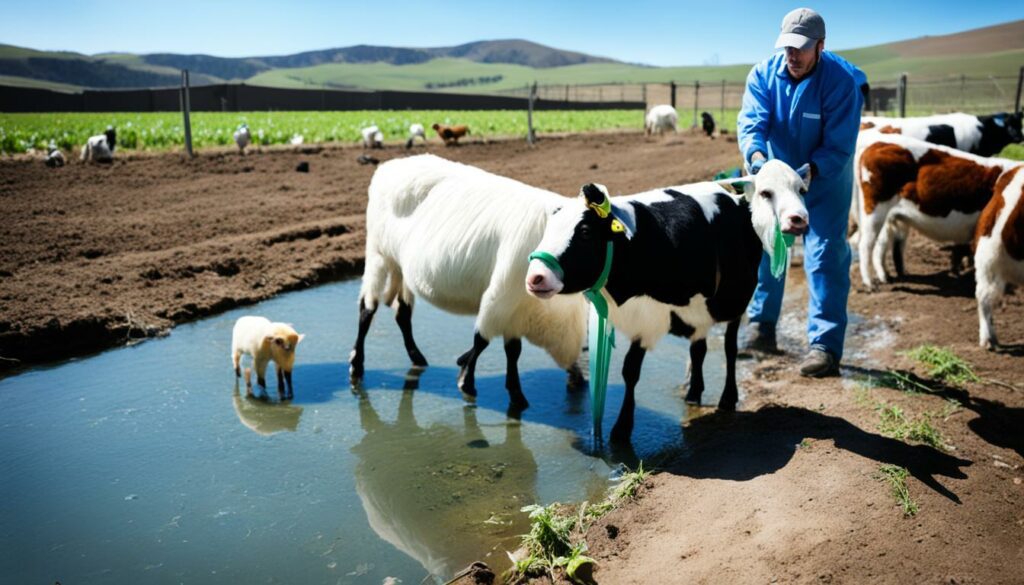
Hens love to dust-bathe, a 20-minute spa for them. This has to be in places where they can move freely. Giving them space to use this habit helps keep them happy and healthy.
Priya Motupalli says we should farm using what we know works best for the animals. When 96% of them show happy habits, we know we’re doing something right.
Most birds and chickens like to dust-bathe, showing they’re feeling good. When we talk online, most of us agree that how chickens are raised affects how they feel. About three-quarters say this.
High agritourism hygiene standards are a must. It keeps the animals safe and makes the farm a great place to visit. Here’s a table showing some important numbers to help you understand better:
| Statistic | Percentage |
|---|---|
| Animals exhibiting natural behaviour | 96% |
| Jungle and domestic fowl engaging in dust-bathing | 93% |
| Stakeholders endorsing stereotypy as a welfare indicator | 81% |
| Citizens supporting freedom of movement for sows and piglets | 82% |
| Laying hens showing behavioural needs, priorities, and preferences | 89% |
It’s really important that farms feel comfortable for visitors. This helps to make agritourism fun and memorable. Places need clean toilets, easy-to-find parking, and comfy areas to sit. These things are key for anyone to enjoy the farm.
About 17 million people in the US look at how green a place is. Half of them love little places run by locals. Making sure toilets are clean and nice is super important. It really makes guests happy.
Access is vital for a farm to welcome lots of people. Minnesota saw 39 million visits in just a year. Good parking that follows the ADA rules makes sure everyone can visit. Signs and clearly marked spaces help those travelling for adventure.
Having spots to rest is a must for inviting guests. It lets them relax and enjoy the beauty around them. Places with seats, shade, and maybe somewhere to picnic make a huge difference. These comforts are great for all kinds of visitors, making them want to stay longer.
Looking at what has worked in other places, like in France, can show farms how to be welcoming. Good planning helps to build spaces that make guests happy and wanting to come back.
Marketing agritourism attractions should focus on the farm animal encounters’ unique appeal. Forbes reported a 67% increase in travellers looking for outdoor activities in late 2018. This trend opens a big market opportunity for farm operators. Real interactions with animals make your farm more attractive.
Acquiring farmstay guests means using social media well. In January 2019, 72% of U.S. adults were on social media. It allows you to reach more people and talk to them directly. Using social media for campaigns that show animal interactions and farm life can really draw people in.
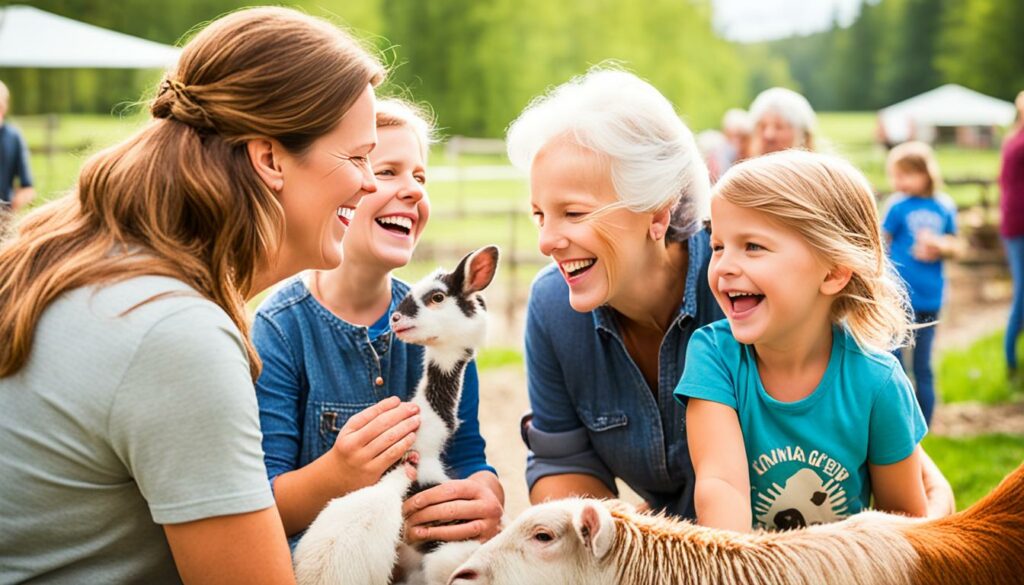
Promoting farm animal encounters with the right kind of content is key. Data from TripAdvisor shows a 61% increase in bookings for tourist classes like cooking in 2018. This shows a growing interest in hands-on and learning-based travel. Highlighting the educational side of farm animal visits can pull in families and school groups. Offering theme tours and hands-on activities makes your farm a more interesting place to visit.
| Marketing Strategy | Impact on Visitor Attraction |
|---|---|
| Social Media Campaigns | Wide Reach and Direct Engagement |
| Educational Content | Attract Families and Schools |
| Real-time Interactions | Enhanced Visitor Interest |
To get more farmstay guests, use online booking. This improves the guest experience from the first interest to actually booking. Also, using data analytics can help target the right people better. It makes your promotions more effective, helping your farm experiences shine in the agritourism field.
It’s vital to collect feedback from farmstay guests. This helps in meeting their expectations better. By asking for honest opinions through various strategies, we improve continuously.
Reviews after the visit are a treasure. We ask guests to share their thoughts right away. This way, we get real impressions. Good reviews help in marketing. But, we also learn from bad reviews to improve.
Collecting feedback means more than just reviews. We use emails, surveys, and forms. These tools let guests share details about their visit. With this info, we figure out what we do well and what needs work. By studying feedback, we make sure every visitor has an amazing time.
Exploring farm animals in agritourism provides many benefits. It boosts guests’ experiences by creating emotional bonds with animals. This, in turn, positively affects their emotions. Moreover, visitors learn about animal care and the importance of sustainability.
Direct interaction with animals is also entertaining. It makes the visit memorable. However, including these experiences mandates detailed planning. They must meet visitors’ expectations and ensure safety for both humans and animals.
By using feedback, farm visits can continually improve. This will make sure the visits are long-lasting and positive for both guests and animals. It’s vital to stay informed on animal behaviour to enhance the experience.
Focusing on the guest’s experience, educational benefits, and animal wellbeing will make farm visits outstanding. They will be more than just vacations but valuable experiences. This could inspire more people to appreciate and support agriculture. For more information, you can check out this article.
Farm animal meets build emotional ties, offer learning chances, and fun value. Visitors can connect with the creatures, discover about farming, and delight in hands-on experiences.
Get your visitors involved by letting them milk goats or gather eggs. Also, give tours with guides and set up feeding sessions. These things make guests’ visits unforgettable.
Planning with a theme, making sure the information suits different ages, and focusing on subjects like animal care and the environment are key. These steps are important for providing valuable lessons to your visitors.
Make sure the animals are friendly. Also, keep the place clean and have safety rules. Don’t forget regular health checks and proper training for the animals.
Try tours for different seasons, those for special interests, and ones kids will love. These can show off many parts of farm life and interest various guests.
Mix time with farm animals and seeing local wildlife for a full farm experience. It’s important to let both groups act naturally.
Therapy with animals can help visitors heal, relax, and feel less stressed. Including such programs can welcome those looking for a personal health boost.
Pick animals that are friendly and fit well with your visitors. Also, think about the space and what different species can teach your guests.
To get your animals ready for guests, use good training methods and keep them healthy and safe. Regular vet visits are a must for their well-being and happy interactions with visitors.
High cleanliness is essential for visitors and the animals’ well-being. Actions like grooming and dust-bathing can also teach and entertain your guests.
Have clean toilets, easy parking, and nice resting spots. Follow ADA rules and use clear signs to make visitors feel welcome.
Use the internet, social media, and special materials to share your farm’s story. Show what makes your place unique to bring in new visitors and keep them coming back.
Get feedback from guest reviews and other ways. Use what they say to make your services better. Happy guests who return and talk about it help your business grow.